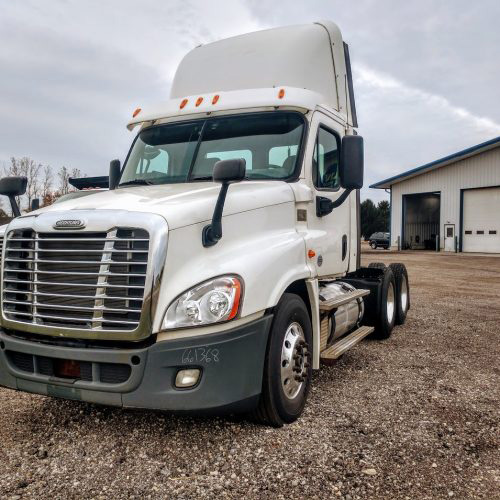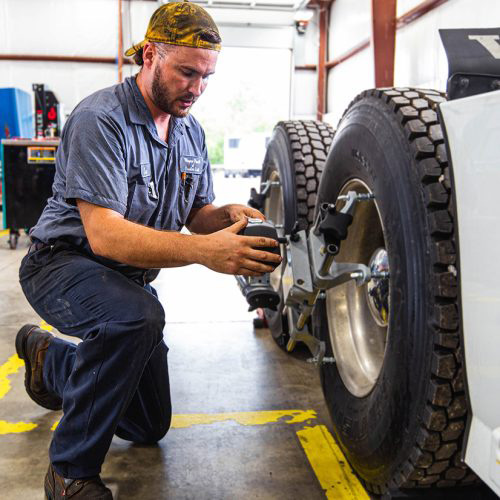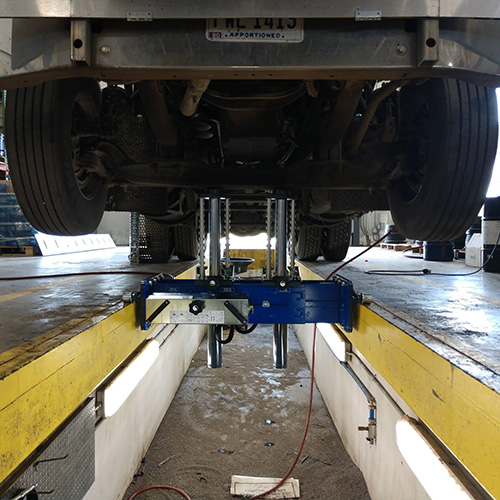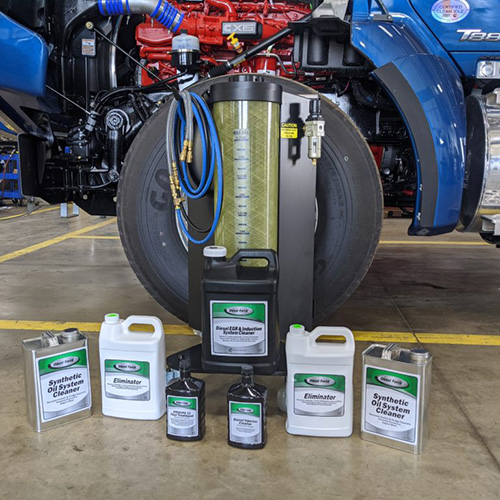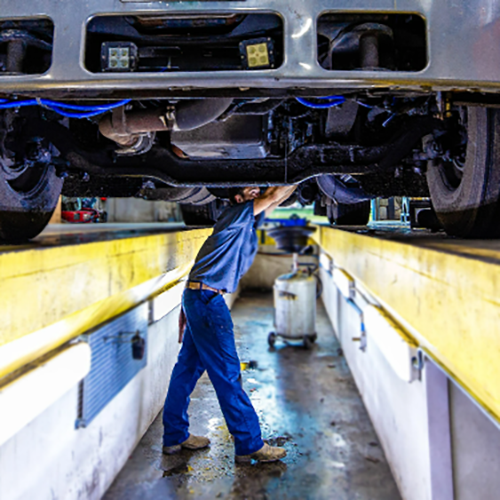How To Tell If Your Semi Truck Needs A Wheel Alignment
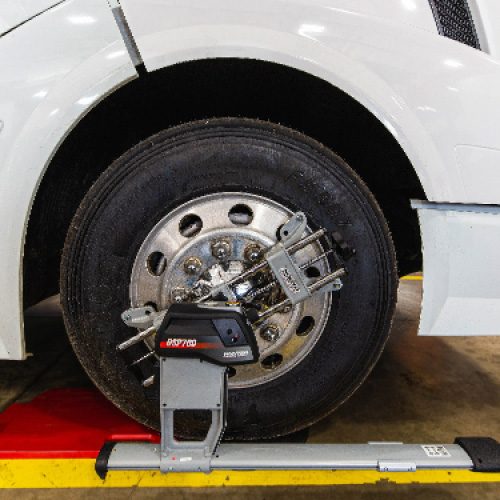
Are you a semi-truck owner or operator who wants to ensure your vehicle runs properly and safely?
If so, regularly checking the wheel alignment of your semi truck should be an essential part of your routine.
Wheel misalignment can significantly reduce your tires’ life expectancy and steering and suspension components.
If left unaddressed, driving with incorrect alignment could also have serious safety repercussions due to steering difficulties and premature tread wear.
In this blog post, we will teach you how to tell if your semi truck needs a wheel alignment so you can make sure that it’s always safe on the road!
Table of Contents
Signs of Alignment Problems with Your Semi Truck
Irregular tire wear pattern
Misalignment occurs when the angles of the wheels are not correctly adjusted, causing them to point in different directions.
Uneven tire wear results because the tires are not making proper contact with the road surface.
When a semi-truck or commercial vehicle is misaligned, certain areas of the tires may bear more weight and friction than others. This causes uneven distribution of pressure and leads to irregular tire wear patterns.
For example, suppose the wheels are toe-in (pointing towards each other). In that case, the outer edges of the tires will experience excessive wear.
Conversely, if the wheels are toe-out (pointing away from each other), the inner edges of the tires will wear down quickly.
Examples of different tire wear patterns
- Feathering: Feathering refers to a tread pattern where the tire tread blocks have smooth edges on one side and sharp edges on the other, creating uneven tread wear. This is typically caused by toe misalignment, where the tires are not parallel to each other. One tire “feathers” inwards while the other feathers outwards.
- Cupping: Cupping results in a scalloped or wavy appearance on the tire tread, with depressions forming in between. This type of wear pattern is often caused by a combination of misalignment and suspension issues. It can occur due to a bouncing motion of the tire caused by imbalanced or worn-out shocks.
- Camber wear: Camber wear is characterized by tire wear on one side of the tread. When the top of the tire tilts inward or outward, it leads to camber wear. This can be a result of misaligned axles or suspension problems.
- Shoulder wear: Excessive wear on the outer or inner shoulder of the tire indicates misalignment. If the tires lean too much inward (negative camber) or outward (positive camber), it can cause uneven wear on the shoulders.
- Center wear: Center wear occurs when the center of the tire tread wears down faster than the outer edges. This can be caused by over-inflation, where the tires are inflated beyond the correct inflation pressure.
It’s important to regularly inspect your semi truck’s tires for these wear patterns, as they can indicate misalignment issues.
Addressing misalignment promptly can help prolong the life of your new tires and ensure your truck’s safe and efficient operation.
Steering pull
Steering pull refers to a phenomenon where a vehicle tends to veer or drift to one side of the road while driving, even when the steering wheel is held straight.
Instead of maintaining a straight path, the driver reports the truck pulls to the left or right.
This pull can make it challenging to keep the vehicle traveling in a straight line without continuous correction from the driver, causing driver fatigue.
Misalignment of the wheels can lead to steering pull in several ways:
- Camber misalignment: This will cause the vehicle to pull towards the side with the more positive camber.
- Toe misalignment: Unequal toe alignment on the left and right sides will cause steering pull as one side of the vehicle experiences more resistance and drags the vehicle in that direction.
- Caster misalignment: A higher positive caster angle on one side will create a tendency for the vehicle to pull towards that side.
When the wheels are misaligned, the forces acting on the tires are imbalanced, resulting in uneven rolling resistance.
This imbalance can cause the vehicle to drift or pull toward the misaligned wheels.
It’s essential to address wheel misalignment promptly to prevent excessive tire wear, handling issues, and potential safety concerns.
Vibrations in the steering wheel or vehicle
Misalignment causes the wheels to rotate unevenly, causing the tires to wear down unevenly, creating vibrations that travel up the undercarriage of the vehicle.
In some cases, this vibration can cause damage to various parts of the truck and lead to an increase in maintenance costs.
Crooked steering wheel
A crooked steering wheel happens when your truck’s wheels are not properly squared with each other or are not perpendicular to the ground.
This misalignment affects how your truck handles and can cause uneven tire wear.
Ignoring the signs of misalignment can become a safety hazard when driving at high speeds.
So, next time you notice that crooked steering wheel, take your vehicle in for a check-up to ensure your wheels are correctly aligned.
Handling difficulties
When a truck is misaligned, the wheels are not properly aligned with the rest of the vehicle. This can cause the truck to drift to one side or the other, making it difficult to stay in one lane.
Misalignment can also cause the tires to wear unevenly, affecting the vehicle’s handling and stability.
Drivers need to pay attention to the alignment of their trucks and address any issues as soon as they arise.
Importance of Professional Wheel Alignment Services
Professional front-end alignments are necessary for semi-trucks and heavy-duty vehicles for several reasons:
Improved Vehicle Safety:
Proper wheel alignment ensures that the vehicle handles correctly and responds accurately to steering inputs, leading to safer driving conditions.
Misaligned wheels can cause the vehicle to pull to one side, affecting stability and increasing the risk of accidents.
Extended Tire Life:
Professional alignment helps distribute the weight and forces evenly across the tires, reducing uneven wear patterns.
This extends the lifespan of the tires, saving money on premature replacements.
Enhance Your Truck’s Fuel Efficiency:
Misaligned wheels create additional rolling resistance, increasing fuel consumption and fuel costs.
Professional alignment creates a straighter roll position and less roll resistance, optimizing fuel efficiency and reducing operating costs.
Improved Handling and Stability:
Properly aligned wheels improve the vehicle’s maneuverability and overall performance.
It provides better control during turns, reduces vibrations, and enhances the driver’s ability to maintain stability on different road surfaces.
Prevents Damage to Suspension Components:
Misalignment stresses suspension components such as tie rods, wheel bearings, and bushings. Over time, this can lead to premature steering component wear and costly repairs. Professional alignment helps preserve these critical parts and ensures their longevity.
Compliance with Manufacturer Recommendations:
Many truck manufacturers recommend regular alignment as part of routine maintenance to maintain warranty coverage. Following these recommendations helps protect your investment and ensures that your truck performs optimally.
By seeking professional alignment services for semi trucks and commercial vehicles, owners can enjoy the benefits of:
- improved safety
- extended tire life
- enhanced fuel efficiency
- better handling
- reduced maintenance costs
When and How Often to Get a Wheel Alignment for Your Semi Truck
When and how often to get a wheel alignment for your semi truck depends on various factors, including mileage, usage, and signs of misalignment.
Here are some insights into determining when to get a tire alignment:
Frequency: Generally, having your semi truck’s wheels aligned at least once every two years or 100,000 miles is recommended.
However, this can vary depending on factors such as the type of use, road conditions, and driving habits.
Signs of Misalignment: It is important to pay attention to signs of misalignment, such as:
- uneven tire wear
- pulling to one side
- vibrations
- steering wheel off-center
It is advisable to have regular wheel alignments as part of your regularly scheduled maintenance to prevent potential problems.
Conclusion
Understanding your vehicle’s signs is key to recognizing when your semi truck needs a wheel alignment.
Suppose your semi truck shows signs such as rapid tire wear, vibration, or not driving straight.
In that case, these are all indicators you may need an alignment.
Furthermore, to prevent significant and costly repairs down the road on your tractor-trailer combo, it’s essential to have routine wheel alignments.
This way, you can ensure your semi truck is kept in tip-top shape. Ensure that everything from the rear axles to the steering wheel is handled.
Call Wayne Truck & Trailer today for expert semi-truck alignment services.
Our team is made up of certified technicians who specialize in realignment services for heavy-duty trucks and trailers.

